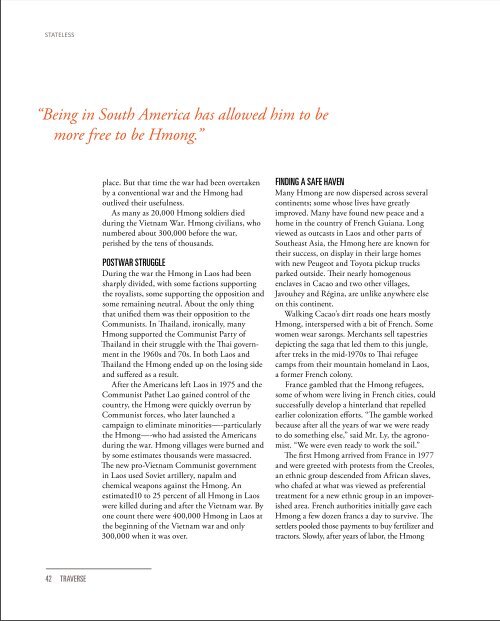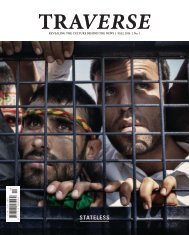Create successful ePaper yourself
Turn your PDF publications into a flip-book with our unique Google optimized e-Paper software.
STATELESS<br />
“Being in South America has allowed him to be<br />
more free to be Hmong.”<br />
place. But that time the war had been overtaken<br />
by a conventional war and the Hmong had<br />
outlived their usefulness.<br />
As many as 20,000 Hmong soldiers died<br />
during the Vietnam War. Hmong civilians, who<br />
numbered about 300,000 before the war,<br />
perished by the tens of thousands.<br />
POSTWAR STRUGGLE<br />
During the war the Hmong in Laos had been<br />
sharply divided, with some factions supporting<br />
the royalists, some supporting the opposition and<br />
some remaining neutral. About the only thing<br />
that unified them was their opposition to the<br />
Communists. In Thailand, ironically, many<br />
Hmong supported the Communist Party of<br />
Thailand in their struggle with the Thai government<br />
in the 1960s and 70s. In both Laos and<br />
Thailand the Hmong ended up on the losing side<br />
and suffered as a result.<br />
After the Americans left Laos in 1975 and the<br />
Communist Pathet Lao gained control of the<br />
country, the Hmong were quickly overrun by<br />
Communist forces, who later launched a<br />
campaign to eliminate minorities—-particularly<br />
the Hmong—-who had assisted the Americans<br />
during the war. Hmong villages were burned and<br />
by some estimates thousands were massacred.<br />
The new pro-Vietnam Communist government<br />
in Laos used Soviet artillery, napalm and<br />
chemical weapons against the Hmong. An<br />
estimated10 to 25 percent of all Hmong in Laos<br />
were killed during and after the Vietnam war. By<br />
one count there were 400,000 Hmong in Laos at<br />
the beginning of the Vietnam war and only<br />
300,000 when it was over.<br />
FINDING A SAFE HAVEN<br />
Many Hmong are now dispersed across several<br />
continents; some whose lives have greatly<br />
improved. Many have found new peace and a<br />
home in the country of French Guiana. Long<br />
viewed as outcasts in Laos and other parts of<br />
Southeast Asia, the Hmong here are known for<br />
their success, on display in their large homes<br />
with new Peugeot and Toyota pickup trucks<br />
parked outside. Their nearly homogenous<br />
enclaves in Cacao and two other villages,<br />
Javouhey and Régina, are unlike anywhere else<br />
on this continent.<br />
Walking Cacao’s dirt roads one hears mostly<br />
Hmong, interspersed with a bit of French. Some<br />
women wear sarongs. Merchants sell tapestries<br />
depicting the saga that led them to this jungle,<br />
after treks in the mid-1970s to Thai refugee<br />
camps from their mountain homeland in Laos,<br />
a former French colony.<br />
France gambled that the Hmong refugees,<br />
some of whom were living in French cities, could<br />
successfully develop a hinterland that repelled<br />
earlier colonization efforts. “The gamble worked<br />
because after all the years of war we were ready<br />
to do something else,” said Mr. Ly, the agronomist.<br />
“We were even ready to work the soil.”<br />
The first Hmong arrived from France in 1977<br />
and were greeted with protests from the Creoles,<br />
an ethnic group descended from African slaves,<br />
who chafed at what was viewed as preferential<br />
treatment for a new ethnic group in an impoverished<br />
area. French authorities initially gave each<br />
Hmong a few dozen francs a day to survive. The<br />
settlers pooled those payments to buy fertilizer and<br />
tractors. Slowly, after years of labor, the Hmong<br />
42 <strong>TRAVERSE</strong>



